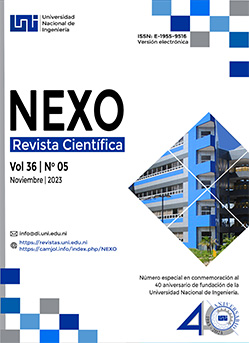Scale up proposal for the spray drying process of hebernem-s bionematicide
DOI:
https://doi.org/10.5377/nexo.v36i05.17309Keywords:
Sauter diameter, Efficiencies, Scale-up, Spray drying, Mathematical model, EnthalpiesAbstract
The need for robust spray dryer scale-up methods is essential to control critical quality attributes in the biopharmaceutical industry. In this second part, various parameters are determined such as the heat capacity of the cream (value of 3.626 kJ/kg.ºC), the enthalpies and mass flowrates of the different streams involved, the Sauter diameter (88.78 μm), the drying total time (6.90 s) and the efficiencies. A mathematical model was also obtained by using MATLABÒ software, in order to determine the main phenomenological characteristics of the evaluated spray drying process. In general, the increase in the cream feeding temperature, the powder temperature, the cream dry mass and the rotation speed of the atomizer decrease the final humidity of the powder, while the air inlet temperature and the absolute air humidity increase it. The temperature of the powder at the exit of the cyclone and the rotation speed of the atomizer disk are the variables that most influence the scale-up of spray drying. The new mathematical model obtained in this work quantitatively describes the spray-drying process of HeberNem-SÒ bionematicide.
Downloads
1589
Downloads
Published
How to Cite
Issue
Section
License
Copyright (c) 2023 Universidad Nacional de Ingeniería

This work is licensed under a Creative Commons Attribution 4.0 International License.
The authors who publish in Nexo Scientific Journal agree to the following terms:
- Authors retain the copyright and grant the journal the right of the first publication under the license Creative Commons Attribution License, which allows others to share the work with a recognition of the authorship of the work and the initial publication in Nexo Scientific Journal.
- Authors may separately establish additional agreements for the non-exclusive distribution of the version of the work published in the journal (for example, in an institutional repository or a book), with the recognition of the initial publication in Nexo Scientific Journal.
- Authors are allowed and encouraged to disseminate their works electronically (for example, in institutional repositories or in their own website) before and during the submission process, as it can lead to productive exchanges, as well as earlier and greater citation of published works.










